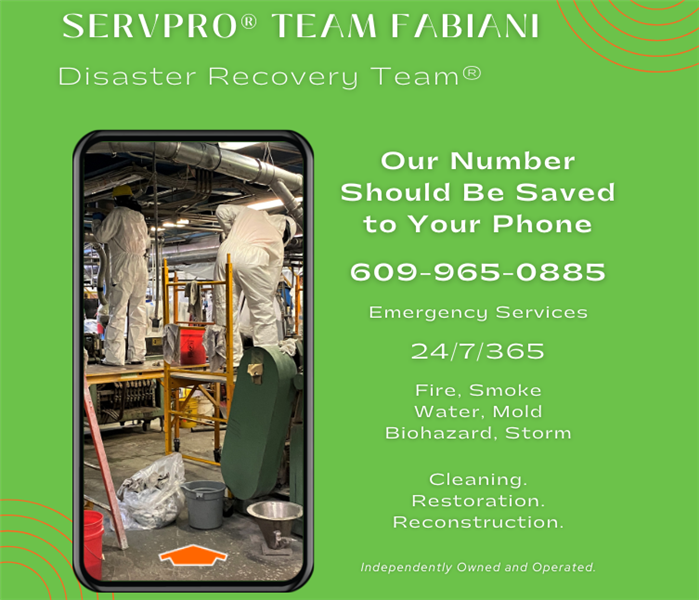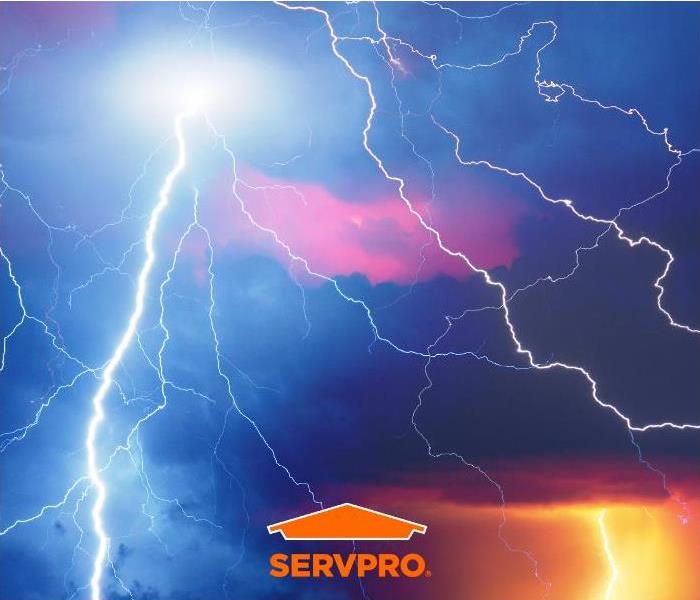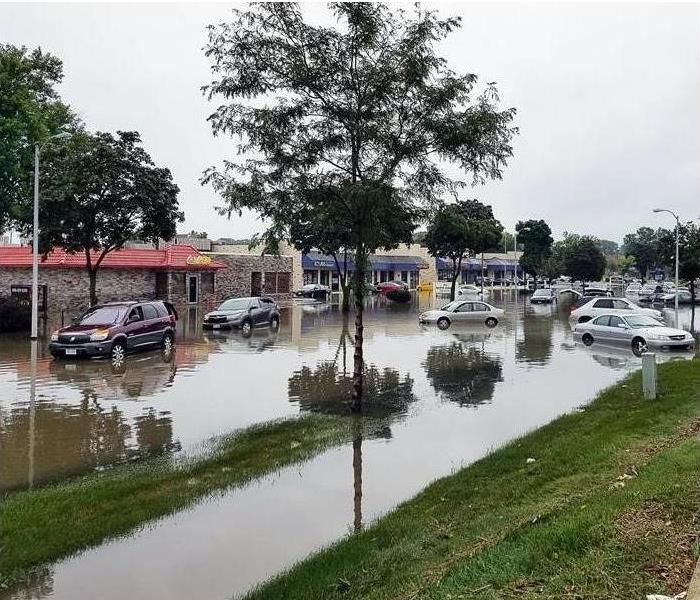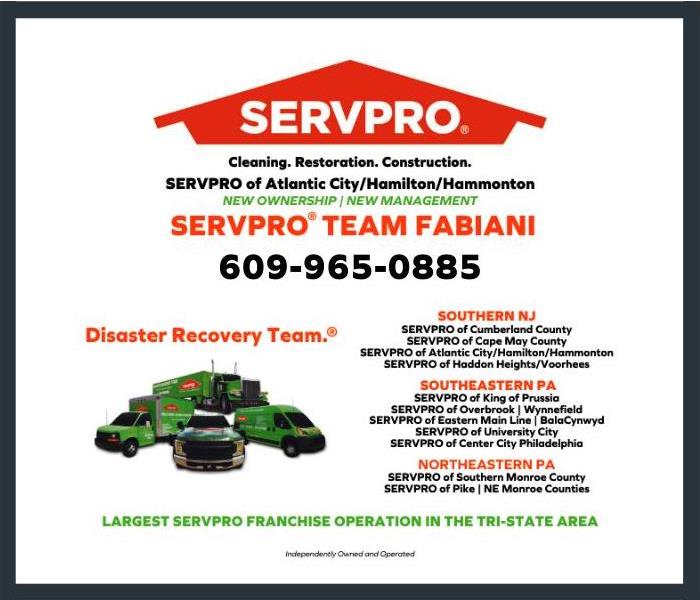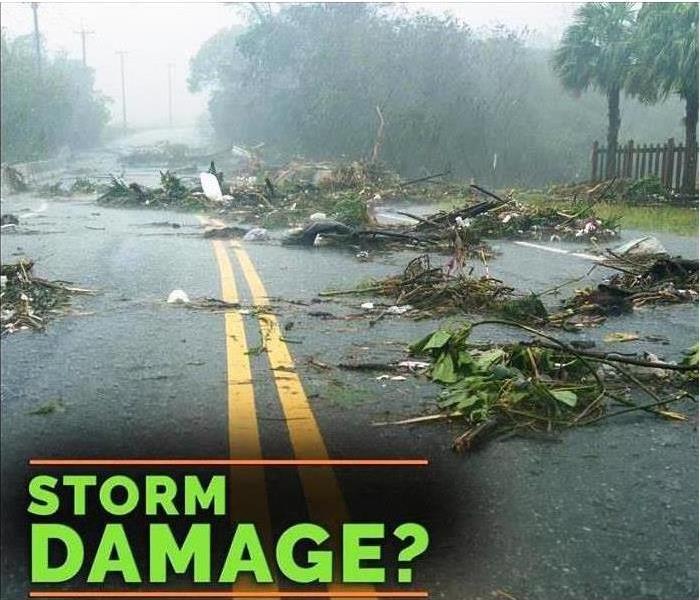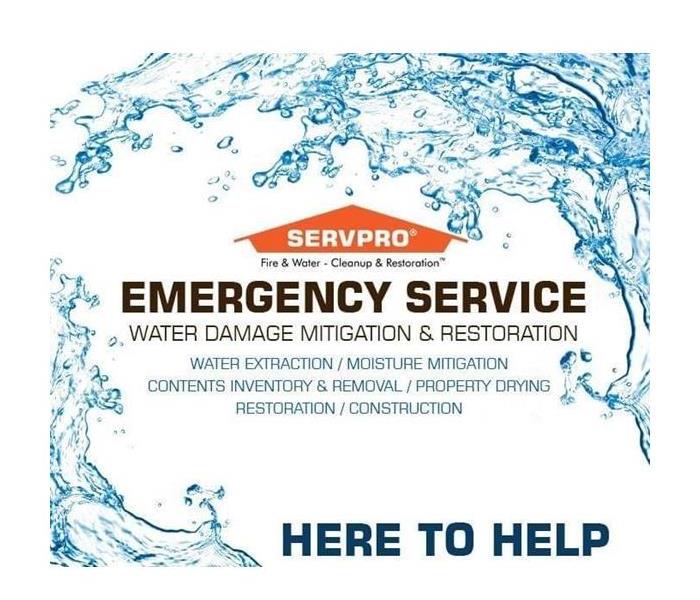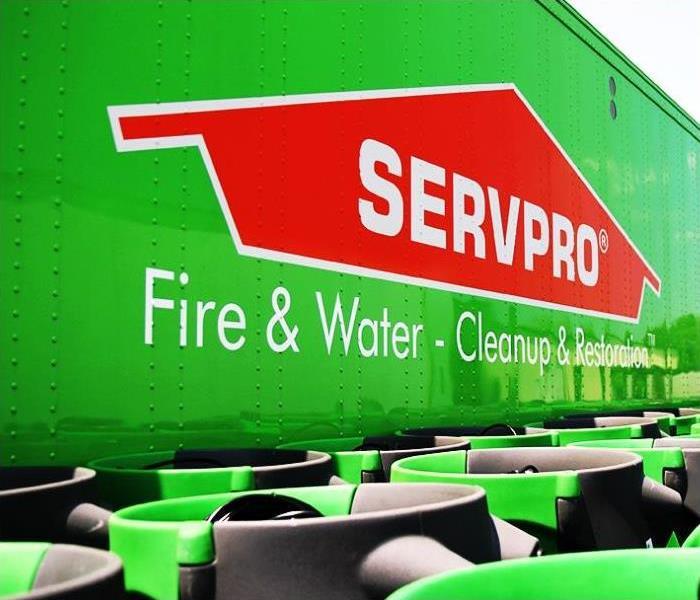Archived Storm Damage Blog Posts
Spring Storms Roll Through Southern NJ
2/27/2024 (Permalink)
A line of severe storms rolled through parts of Southern New Jersey on Tuesday afternoon. If your home or business has suffered damage contact SERVPRO of Atlantic City/Hamilton/Hammonton. Our certified technicians provide 24-hour emergency service and will respond immediately to your emergency water damage. We have the expertise to handle your water damage restoration or cleaning needs by providing:
- 24 -Hour Emergency Service
- Water Extraction and Dehumidification
- State of the Art Equipment
- Highly Trained Water Restoration Technicians
- Direct Insurance Billing
When a major storm passes close to the house, the home may suffer water damage that is difficult to repair.
Professional restoration services can quickly identify what items in the home are compromised by water damage. Normally, anything that is porous may need to be discarded if it has come in contact with contaminated fluids. These items, like mattresses, box springs, pillows and particle board, trap more moisture than other materials and foster the growth of microbes.
The main reason a home is sensitive to water damage is because moisture is difficult to detect once the floods recede. Standing liquids can encourage microbial growth within 24 hours and can saturate all kinds of textiles and seep through drywall. Moisture may collect behind the walls, where mold and bacteria may multiply out of sight.
You can prepare for professional cleaning by getting rid of these items before the technicians arrive, but be sure to properly record and itemize the items for insurance purposes prior to disposing.Once professionals arrive at the building, they will be able to track down any pockets of excess moisture and remove them.
Need help? Call us today at 609-965-0885
Here's How to Avoid Frozen Pipes in Cumberland County!
2/3/2023 (Permalink)
Tips to Help Prevent Pipes from Freezing in Cumberland County.
The three central causes of frozen pipes are quick drops in temperature, poor insulation and thermostats set too low. Here's help for property owners in Bridgeton, Millville and Vineland.
- Insulate pipes. Pipe insulation in your home's crawl spaces and attic helps even if you live in a climate where freezing is uncommon. Exposed pipes are most susceptible to freezing. Remember, the more insulation you use, the better protected your pipes will be.
- Use heat tape or heat cables. Heat tape or thermostatically controlled heat cables can be used to wrap pipes. Be sure to use products approved by an independent testing organization, such as Underwriters Laboratories Inc., and only for the use intended (exterior or interior). Closely follow all manufacturer's installation and operation instructions.
- Seal leaks. Locate and thoroughly seal leaks that allow cold air inside. Look for air leaks around electrical wiring, dryer vents and pipes, and use caulk or insulation to keep the cold out.
- Secure outdoor hoses, valves and faucets. Before winter hits, disconnect garden hoses and, if possible, use an indoor valve to shut off and drain water from pipes leading to outside faucets. This reduces the chance of freezing in the short span of pipe just inside the house.
- Let water drip. A trickle of hot and cold water might be all it takes to keep your pipes from freezing. Let warm water drip overnight when temperatures are cold, preferably from a faucet on an outside wall.
- Adjust the thermostat. Keeping your thermostat set at the same temperature during both day and night also reduces the risk of frozen pipes. During extreme cold, this also helps reduce the strain on the furnace.
- Open cabinet doors. This allows heat to get to un-insulated pipes under sinks and appliances near exterior walls.
Anything can happy in severely cold and windy weather. If you should have frozen pipes that burst or any other wind or storm damage, SERVPRO® Team Fabiani has the experience and equipment to restore your property back to preloss condition ASAP. We also provide emergency services such as boardups, roof tarping and more. Call 609-965-0885. We're Here to Help® 24/7/365!
Unaddressed Flood Damage in Hamilton Township
11/21/2022 (Permalink)
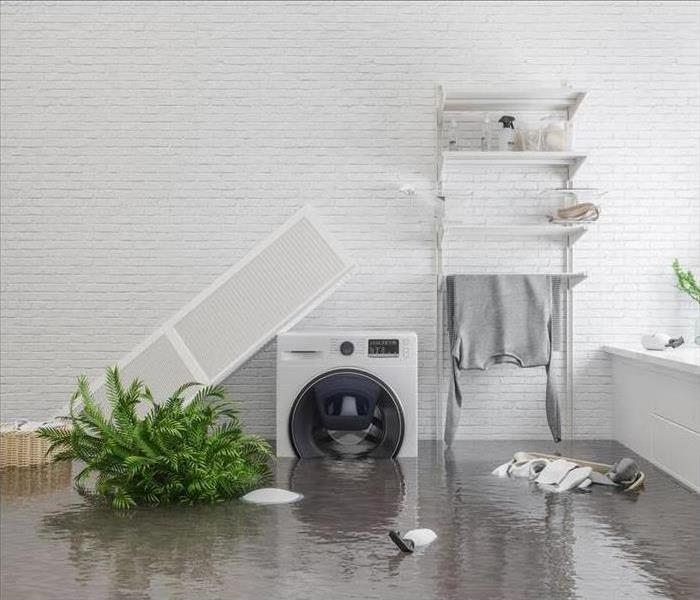 Let SERVPRO weather the storm with you. Call us at 609-965-0885 and let our expert team take charge.
Let SERVPRO weather the storm with you. Call us at 609-965-0885 and let our expert team take charge.
Restoration Services in Hamilton Township After a Storm
Storms can be nothing more than a nuisance, but sometimes they bring a significant cadre of problems for homeowners. How you handle them and who you enlist to help can make all the difference between it being merely an anecdote or becoming the bane of your existence.
Understanding that storm water carries debris and pollutants into your home and that they need to be handled by professionals is the first step in a successful restoration process.
In Hamilton Township, flood damage restoration services are our specialty at SERVPRO. We focus on mitigating your losses while applying a framework focused on safety and efficiency. When our certified water restoration technicians dedicate their time to your home, we seek to restore whenever possible, including your hardwood floors.
These are some of the steps we might take in your Hamilton Twp. property:
- Utilize a wand extractor to remove excess water
- Remove a few planks and utilize drying mats to vacuum out the water
- Apply EPA-approved anti-microbial solutions
Let SERVPRO weather the storm with you and give you more time to explore the beautiful Egg Harbor River and the wonderful history of Hamilton Township.
Call us at 609-965-0885 and let our expert team take charge. We're available 24/7/365!
Preparing for Thunder & Lightning Storms
6/1/2022 (Permalink)
Preparing for severe weather is critical to your safety and keeping your property safe from damage.
30/30 Rule for Lightning
- If there is less than 30 seconds between a flash of lightning and the sound of thunder, seek shelter.
- Wait at least 30 minutes from the last sound of thunder before leaving shelter.
Severe weather can happen anytime, in any part of the country. Severe weather can include hazardous conditions produced by thunderstorms, including damaging winds, tornadoes, large hail, flooding and flash flooding, and winter storms associated with freezing rain, sleet, snow and strong winds.
Know your Risk
Understand the type of hazardous weather that affects you and your family where you live:
Lightning is a leading cause of injury and death from weather-related hazards. Although most lightning victims survive, people struck by lightning often report a variety of long-term, debilitating symptoms.
Thunderstorms are dangerous storms that include lightning and can create or cause:
For more tips on preparing for thunder and lightning storms follow these tips from Ready.Gov: Prepare for Thunder & Lightning.
If your property is damaged in a severe storm, call the experts at SERVPRO of Atlantic City/Hamilton/Hammonton, 609-965-0885. We're a preferred vendor for many insurance companies and can work with you and them to get you back up and running as quickly as possible.
Preventing Flood Damage to Your Property
5/20/2022 (Permalink)
Flooding is a year-round concern in Atlantic City, Hamilton Township and Hammonton.
According to the Federal Emergency Management Association ("FEMA"), “Flooding is the most common and costly disaster in the United States.” FEMA also recommends that homeowners take 3 important steps to minimize flood damage: “Know Your Risk”, “Insure Your Property”, and “Reduce Your Risk.” In this blog, we’ll discuss ways in which you can reduce your property’s risk for experiencing flood damage in accordance with FEMA’s guidelines.
Preventative Measures Inside and Outside
There is a wide array of indoor and outdoor preventative measures that you can take in order to best protect your home or business from flooding damage both well in advance or immediately before the storm hits. Outside, be sure that you clean out your gutters regularly, as doing so prevents them from becoming clogged and helps rainwater drain properly during a storm. Outdoor equipment and utilities, including heat pump or air conditioning units, can be elevated at least 1 foot off of the ground in order to decrease the potential for costly water damage during a flood. Inside, it may also be beneficial to elevate your indoor units, such as your HVAC system, in the event of indoor flood damage. Lastly, be sure to keep valuable indoor items, which may include important documents and sentimental objects, in watertight containers within a safe, elevated location. This step prevents such items from enduring irreversible water damage in the wake of a flood.
Call SERVPRO® for Professional Storm Damage Restoration
Even with preventative measures in place, storm damage due to flooding is never 100% avoidable. However, taking the steps outlined in this blog and those recommended by Ready.gov can help minimize serious damage.
That’s why SERVPRO® of Atlantic City/Hamilton/Hammonton – Team Fabiani is standing by and Here to Help® in the event that your home or business needs restoration to its preloss condition after a damaging flood. Our website contains various flood and storm damage resources, including: Storm Damage Cleanup and Restoration, Commercial Storm Damage, and Water and Storm Damage Tips.
Call us at 609-965-0885 at the first sign of damage after a flood or severe storm for immediate, professional assistance and restoration services that you can trust. You'll be glad you enlisted the help of a professional.
The SERVPRO® You Trust With Storm Damage
5/7/2022 (Permalink)
When your Atlantic City or Hammonton home or business has been damaged by a storm, preventing further destruction from the elements with tarp placement and protective measures can be crucial.
We provide 24 hour emergency services including tarp placement, temporary fencing, temporary power and more to Atlantic City, Hamilton Twp. and Hammonton.
We are locally owned and operated, and our experienced Franchise Professionals are quick to respond and Here to Help® 365 days a year. We're the company you can trust to get the job done right the first time.
Call the restoration company you can trust: SERVPRO® of Atlantic City / Hamilton / Hammonton. If you’ve been hit with a disaster, call us: 609-965-0885.
Be Prepared for Storm Damage!
3/13/2022 (Permalink)
Prepare Now for Spring Severe Weather and Storms.
According to the National Weather Service, March marks the start of the spring severe weather season: “…three months of danger that can imperil the unprepared.1”
Data published by the National Oceanic and Atmospheric Administration (NOAA) reveals that severe weather events are becoming more frequent and more devastating. NOAA reports that the period from 1980-2021 saw an annual average of 7.4-billion-dollar weather and climate events (adjusted to today’s costs). When they looked at only the five most recent years (2017-2021), the annual average grew to 17.2 events. 2021 delivered 20 “billion-dollar” weather or climate disaster events.
It’s not unusual to see severe weather in the spring. Whenever you have warm, moist air colliding with cool, dry air, you have the conditions for creating a thunderstorm, along with the possibility of lightning strikes, floods, hail, high winds, rip currents, and even wildfires and tornadoes. The problem is, you can’t prevent these severe weather events and you can’t predict very far in advance when and where they will hit. The only sensible approach is to take steps in advance to protect your family and property, especially as these disasters become more common.
The Disaster Recovery Specialists at SERVPRO of Atlantic City/Hamilton/Hammonton urge Atlantic City area property owners to check out state and federal resources online for tips on planning and preparing for a severe weather emergency now, as the spring severe weather season arrives. One such resource is the National Center for Environmental Health of The Centers for Disease Control and Prevention (CDC), which offers suggestions for creating an emergency kit and preparing family members for severe weather emergencies.
Each year, SERVPRO Franchise Professionals across the country respond to scenes of weather-related mayhem, helping families and business owners recover from flooding, fire, wind damage and more. While we are standing by to help whenever we are needed, we hope that our neighbors in the Atlantic City area will heed the warning from the CDC to prepare for storms, floods, and tornadoes as if you know in advance they are coming, because in the spring, they very likely will.
SERVPRO specializes in disaster cleaning, restoration, and construction services, helping to remediate damage, making it “Like it never even happened,” for both commercial and residential customers. For more information on SERVPRO of Atlantic City/Hamilton/Hammonton, please call 609-965-0885 or email us.
Worried About Water Damage in Atlantic City?
2/23/2022 (Permalink)
SERVPRO Helps Eliminate Hazards After an Atlantic City Flood.
Besides the visible damage caused by flooding, it is essential to consider other safety hazards that may pop up through the recovery and repair process. It is not as simple as drying, cleaning, and replacing items in your Atlantic City home or business. Floods can create a chain reaction of hazards. Certified SERVPRO technicians can help you locate and remove dangers from your Atlantic City home or business.
How Should I Handle Hazards?
SERVPRO Uses Safety Protocols to Detect Hazards and to Eliminate Them.
Repairing your Atlantic City property after flood damage is not necessarily a simple task. There can be hidden hazards, and if you are not equipped to find and fix them on your own, you could face dangerous situations. SERVPRO restoration specialists are skilled in detecting and eliminating hazards to help recreate a safe environment. They also have the proper Personal Protective Equipment ("PPE") so that they can protect themselves.
What Types of Hazards Does Flooding Cause?
• Electrical Hazards: Flooding often brings water into wiring, water and electricity do not mix. When in doubt, it is vital to turn off the power main to ensure safety for residents and workers.
• Structural Hazards: Flooding can weaken building materials like drywall or flooring, impacting your home's structural integrity.
• Biohazards: Floodwater can include water from sewage and other unknown locations that may carry contaminated water.
What Kind of PPE Do Technicians Wear to Protect Against Contaminated Water?
• Respirators for clean breathing purposes
• Chemical resistant gloves in case harsh chemicals are in the water
• Rubber boots, splash goggles, and full-body suits for extreme conditions
For assistance with storm or flood damage, contact SERVPRO of Atlantic City / Hamilton / Hammonton. We're Here to Help® 24/7/365. Call 609-965-0885. We'll make it, “Like it never even happened.”
Storm Damage – Tackling Everything a Step at a Time in Atlantic City
11/7/2021 (Permalink)
 Storm damage restoration services by SERVPRO are top-notch. For fast and immediate help, Call now!
Storm damage restoration services by SERVPRO are top-notch. For fast and immediate help, Call now!
Fall and Winter Storms May Bring Unexpected Damage, But SERVPRO Knows How to Fully Restore Your Atlantic City Home
Nothing is worse than a storm raging and bringing more heavy rain and wind than expected. Depending on temperatures, fall weather heading into winter can even bring sleet and freezing rain to the Atlantic City area. It is imperative that you not only know how to proceed with safety during a storm but where to turn when you have basement flooding or a need for ceiling repairs from water damage to your roof and more. SERVPRO has the staffing and equipment to help you bring your property back to normal so that you can save time, money, and stress throughout it all.
The amount of storm damage you see in Atlantic City depends on many factors. Severity level may relate to the wind, temperatures, and where your property is located. No matter what, flooding and water removal services with SERVPRO give you the peace of mind you need. Not only that, but we are available to get to work within a few hours of your call to provide:
- Professional assessment, which allows our team to select the best equipment and process for the project
- Execution of tailored water removal and drying
- Monitoring of moisture levels, including the use of moisture detection tools and sensors to inhibit the onset of mold, mildew, and secondary damage
- Controlled demolition, as needed, allows our team to remove all saturated materials to replace with new – this makes it “Like it never even happened.”
There are several areas our team can assist with should you be faced with storm damage. This includes but is not limited to:
- Board-up/tarping
- Pack out services
- Document drying
- Drywall removal and replacement
- Roofing repair
- Temporary warehouse space
- Portable power sources
- Odor control, and more!
Dial (609) 965-0885 to speak with a team member at SERVPRO of Atlantic City/Hamilton/Hammonton when you need assistance with storm damage.
Flood Damage from Storms in Hamilton Township Calls for Prompt Action
10/31/2021 (Permalink)
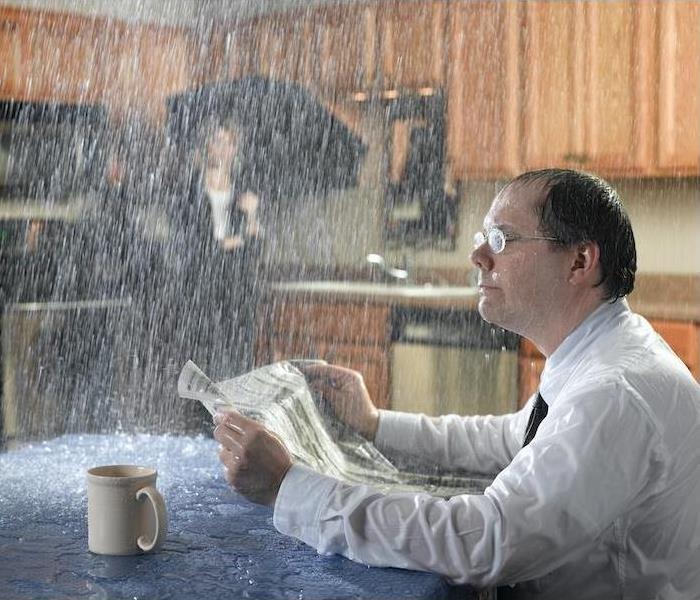 SERVPRO IICRC certified technicians are trained and experienced in all phases of storm and flood damage remediation.
SERVPRO IICRC certified technicians are trained and experienced in all phases of storm and flood damage remediation.
SERVPRO Can Handle Basement Flooding and Other Damage to Restore Your Hamilton Township Property
The rainstorms Hamilton Township residents see each year open up the possibility that you may need to contact someone to assist with water damage restoration at one time or another. Should you have issues with basement flooding or a leaking roof from storms, SERVPRO has a team of skilled water restoration technicians (WRT) to tackle water extraction and drying so that you can limit the chance of secondary damage or mold and mildew growth.
Once you experience a local storm, there are many reasons to call SERVPRO for flood damage in Hamilton Township. We have our processes to help handle water damage remediation effectively. After you contact us for restoration, we will arrive within hours to begin the assessment and planning. Questions that might get answered during this time include:
- Is there a safe, stable electrical supply onsite?
- How much water has entered the basement/home?
- What is the rough distance requiring coverage within the property?
- Are there contaminants present calling for technical measures?
- Will pack-out service be required?
- What tools and equipment should we use for water removal services and drying?
Should you have a finished basement and find that the carpeting or flooring materials are not salvageable, we can remove and replace all of them using our controlled demolition methods. We can also handle flood cuts, baseboard removal, and inner wall drying with our InjectiDry system. General Contractor License #: HIC #13VH05086500
Nothing beats the professionalism and attention to detail that SERVPRO of Atlantic City/Hamilton/Hammonton has to offer. We are available when you need us - 24 hours a day, every day of the week, to handle all of your flood damage needs from start to finish. You can reach us by calling (609) 965-0885.
Can SERVPRO Help Clear Flood Damage from My Home in Hamilton Township?
5/19/2021 (Permalink)
 Flood damage restoration services by SERVPRO are second to none. Call now for the help you need.
Flood damage restoration services by SERVPRO are second to none. Call now for the help you need.
SERVPRO’s Water Clean Up Services After a Flood in Hamilton Township
Flood damage in our area can be widespread, affecting many homes and businesses. The storms bring in heavy rain, high winds, and flooding that inundates neighborhoods. It is important to begin flood restoration operations as soon as possible to reduce primary and secondary water damage before further damage occurs.
That’s why SERVPRO offers flood damage restoration services in Hamilton Township and has the resources to respond to the flood situation. We have extensive resources within our franchise; however, we can call over 1700 Franchises across the country for assistance when catastrophic events occur.
SERVPRO will respond in less than 4 hours from your initial call and has resources available to respond 24/7 to your emergency services water damage event. SERVPRO offers the following services:
- Water Clean Up
- Leaking Roof from Storms including board up and tarpaulin service
- Water damage repairs
Call SERVPRO of Atlantic City / Hamilton / Hammonton for flood damage in Hamilton Township and surrounding areas. We can help 24/7. Call (609) 965-0885.
Where To Look for Flood Damage after a Storm in Atlantic City?
3/22/2021 (Permalink)
 Flood damage done to your home is no easy task. Call the team of IICRC certified techs from SERVPRO for the flood mitigation services needed.
Flood damage done to your home is no easy task. Call the team of IICRC certified techs from SERVPRO for the flood mitigation services needed.
Give your Atlantic City home a once-over with SERVPRO.
Do you check your home after storms and floods? You might assume that flood problems will immediately show up as apparent puddles on your floor, but that is not always the case.
If you are concerned about flood damage to your Atlantic City home after a storm, SERVPRO advises a walk-through of your home. As well as apparent puddles of water, look for signs such as:
- Sagging or swollen-looking ceilings.
- Streaks or patches of water on the floor, ceilings, or walls.
- Wet beams or damp insulation in the attic.
- Water drips or a smell of sewage around the plumbing.
If you see signs of flood damage, call SERVPRO. We can pump out excess water and dry, clean, and deodorize your belongings. We can also oversee structural repairs such as replacing roof shingles or installing new insulation. We can clean everything from your home’s structure to your favorite family knickknacks – no job is too big or too small.
Are you worried about signs of flood damage in your home? Call SERVPRO of Atlantic City / Hamilton / Hammonton at (609) 965-0885.
January Exhibitions at the Grounds For Sculpture (GFS) in Hamilton Township
1/11/2021 (Permalink)
 SERVPRO artfully mitigates storm damage to your Hamilton Township Home!
SERVPRO artfully mitigates storm damage to your Hamilton Township Home!
A Celebration of Bruce Beasley's LifeWorks Kicks Off at Hamilton Township's GFS this January.
Bruce Beasley is a world-renowned abstract artist that was born in Los Angeles in the mid-twentieth century. His works typically rely on impressionist principles using structures made from steel, bronze, glass, and iron. In January next year, the Grounds For Sculpture in Hamilton Township is celebrating sixty years of Beasley's sculptural works. Although guided tours can be booked to gain a greater insight into the workings of this significant sculptural artist, Admissions are free. The exhibition also features some of the artist's latest works made using stainless steel and bronze and collages in the on-site museum.
- The opening times range from 10 am to 6 pm. The GFS is a non-profit ground that opens to the public daily and offers tours of the art pieces and historic sites.
- Some nights the park remains open for a more extended period until 9 pm.
- Reserve tickets for this sculptural celebration by visiting the GFS website
Groundwater flooding typically occurs during periods of heavy rainfall. Contact SERVPRO of Atlantic City / Hamilton / Hammonton at (609) 293-3506 for urgent assistance.
Experience the Vintner Wonderland in Atlantic City this Christmas
12/15/2020 (Permalink)
 Don't Let Stormy Weather Interfere with Your Wine Tasting and Ice Skating in Atlantic City--Says SERVPRO
Don't Let Stormy Weather Interfere with Your Wine Tasting and Ice Skating in Atlantic City--Says SERVPRO
Renault Winery Resort in Atlantic City Celebrates Christmas Season in Style
The annual Vintner Wonderland event is going ahead as scheduled this year at the Renault Winery Resort. The latest addition to this annual fair is the huge outdoor ice rink suitable for all ages from December 21st until the end of February. Alongside the new ice rink is the traditional fair, including horse-driven carriage rides, a shopping and food court as well as sit-downs with Santa. The vineyard here is in one of New Jersey's oldest buildings and is listed on the Register of Historic Places. Despite remaining a wine-making center, the area became a resort in the early 2000s with the opening of a premier golf course. Each year the resort opens to the public with its traditionally themed Vintner Wonderland.
- Tickets for ice skating are recommended to be booked in advance but suitable for all ages.
- Outdoor dining and live entertainment take place throughout the days, and schedules can be checked online.
- The outdoor shopping experience features unique gifts and boutiques for those looking to do some late Christmas shopping.
Protecting your home after a damaging flood relies strongly on removing standing water. Contact SERVPRO of Atlantic City / Hamilton / Hammonton at (609) 293-3506.
What Are the Main Threats of Flash Flooding in Atlantic City?
7/11/2020 (Permalink)
 Our SERVPRO of Atlantic City / Hamilton / Hammonton team can respond quickly to these emergencies to make it “Like it never even happened.”
Our SERVPRO of Atlantic City / Hamilton / Hammonton team can respond quickly to these emergencies to make it “Like it never even happened.”
Flooding in Atlantic City
When your home falls victim to migrating floodwater, there are several immediate concerns for the property that professional restorers should address.
Flash flooding can result from some specific conditions, but because of its frequency in New Jersey, it has become a known threat to Atlantic City structures and homes. Preparedness for these emergencies means developing a plan that determines how your household gets protected and who is responsible for the restoration and recovery of the property from its earliest stages. Flooding can only damage a home more and more, so the faster you secure and dispatch experienced professionals to the house, the better able to protect its materials and contents you become.
As one of the most populated cities in Atlantic County, when flood damage impacts Atlantic City, hundreds of properties are often involved in the disaster. Because we are part of a large loss recovery team, we can pool resources, personnel, and experience with other sister franchises to help during these emergencies. This response reduces the devastation to structures and allows our technicians to control widespread threats that can overtake the entire property.
How Fast Can My Home Get Overwhelmed with Flash Flooding?
The pace and immediate force of flash flooding are some of its most dangerous qualities. While this can be threatening enough to those exposed to the disaster, this faster pace and strength of the water can also lead to many other compromising conditions. How your home gets cleaned and mitigated in these earliest stages can set the expectancy for how much of the property is actually restorable. As with every natural flooding scenario that our professionals face, there are specific conditions that we must expect with flash flooding entering a residence. These include:
• Standing Water – In flash flooding scenarios, standing water in the home could be as much as several feet. We must extract pooled water to the surface to begin cleaning and restoring the property.
• Structural Damage – The exposure of sensitive materials is inevitable. The longer that restoration takes to start, the more of these construction materials that become too deteriorated or compromised to restore.
• Debris – Water entering the home can come with animals, mud, silt, debris, and other potential concerns.
• Contaminants – Natural flooding must get considered to be a Category 3 loss event with contaminated blackwater. There is a high probability that moving water has overwhelmed sanitary sewers and presented other high-contamination risks now circulating in the water.
Why Is Extraction One of the First Steps in Restoration?
Extraction is one of the first steps taken after a flood loss, specifically because of the challenges present in restoration and cleaning without removing standing water. Surface damage like pooling water can continually absorb into surfaces and cause irreparable damage. We have multiple tools to address these concerns in our inventory. Part of choosing the right tool means identifying any debris and solids that might exist in the standing water. Natural flooding can carry in silt, mud, and other debris. Several extractors cannot move solids, so we must choose the right tool as soon as we arrive. With the commonality of water damages and flooding, we keep these extractors pre-stocked and ready to mobilize:
• Submersible Pumps
• Trash Pumps
• Wet Vacuums
• Weighted Extractors
When Can Repairs Occur?
Few flash flooding instances impact area homes without the need for some degree of controlled demolition, build back, or repair. Our SERVPRO professionals have a dedicated team of residential contractors in-house that can help to resolve these situations with fast actions. After a flood, several immediate emergency services must occur, and that is where our experienced contractors begin. These actions include:
• Board Up – Structural breaches allow for more water penetration and other threats. Board up seals these openings to prevent further water flow.
• Tarping – Roofs can also become damaged during violent storms, leaving the property vulnerable in similar ways. We can tarp over these vulnerabilities until the appropriate repairs take place.
• Tree Removal – The force of flash flooding can uproot and knock over trees. When these land on your house or property, our team must work quickly to remove it.
• Controlled Demolition – By only removing the portions of drywall and other structural materials that are too damaged to preserve, we can make build back more efficient and ultimately more cost-effective.
Restoring your home after a flash flood can be a challenge, especially with the high degree of damage that often results. Our SERVPRO of Atlantic City / Hamilton / Hammonton team can respond quickly to these emergencies to make it “Like it never even happened.” Give us a call anytime at (609) 965-0885.
Where Can I Find Brigantine Storm Damage Remediation Services?
5/27/2020 (Permalink)
 SERVPRO is always ready to remediate your storm damage. Call us today!
SERVPRO is always ready to remediate your storm damage. Call us today!
SERVPRO of Brigantine Can Help You Remediate the Storm Damage on Your Property
A sudden and intense thunderstorm could bring storm damage to your Brigantine home. Imagine a scenario where intense winds and rain force your rickety back door to fly open and allow water to pool and gather inside of your kitchen.
You may feel panic upon waking and finding storm damage in your Brigantine home. However, it's essential to remain calm. Calling for help from a company, like SERVPRO, as soon as possible, can help save your home from further damages.
How Fast Can SERVPRO Help My Home?
Our technicians are committed to helping you as soon as possible. We do certain things to help speed up our travel process, such as:
- Pre-loading our equipment into vans, so they're ready to go when you need us
- Assembling a team of storm damage technicians as soon as you call us
- Taking the quickest route to your location
It is important to remember that during storms, roads could be flooded or blocked. However, SERVPRO can still come to your location. We never close our doors and are committed to helping you as soon as possible.
What Can SERVPRO Do to Remove the Water?
Once we get a tarp covering your home's entryway, so water cannot continue to flow inside, we can begin. We can start by:
- Removing the standing water, using devices such as wet/dry vacuums and extractors
- Setting up drying equipment, such as air movers, heaters, and dehumidifiers
- Sending soaked furniture and belongings to a facility to be dried
Once we remove the standing water, SERVPRO can focus on ensuring that the storm damage does not become mold damage.
If you think your home may need storm damage remediation services, get help today. Communicate with SERVPRO of Atlantic City / Hamilton / Hammonton by dialing (609) 965-0885. No matter what time you need us, we're here for you.
More about Brigantine.
Flood Damage In Your Brigantine Home
5/17/2020 (Permalink)
 Keeping control of both short-term and long-term harm is essential in flood restoration.
Keeping control of both short-term and long-term harm is essential in flood restoration.
Is it Really Necessary to Perform Dehumidification after Removing Floodwaters from my Brigantine Home?
Dehumidification may be less Efficient than Pumping or Water Extraction, but it is Essential to Return a Home to its Pre-loss Condition. SERVPRO Incorporates both Emergency Mitigation and Long-term Protection in our Flooding Restoration Service.
When should I use dehumidification in a flooded property?
Flooding requires immediate attention and emergency mitigation. However, once the situation is under control, it is equally vital to employ proper drying techniques to reduce the long-term impact of flood damage in your Brigantine home. Dehumidifying a property can reduce the relative humidity and prevent secondary damages. It can also help to dry out building materials that may have absorbed large amounts of water. SERVPRO usually sets up a dehumidification system toward the end of a flood restoration once immediate concerns are under control.
What can dehumidifiers be used for flood restoration?
• To restore hardwood floors which may absorb excessive amounts of moisture during a flood and start to cup or buckle
• To thoroughly dry contents like upholstery and furniture
• For maintaining relative humidity below 60 percent and slowing potential mold growth while drying procedure is underway
• In larger spaces, large capacity dehumidifiers (LCD) can double up as air moving equipment
What type of dehumidification do I need to restore my home?
The most commonly used dehumidifiers are refrigerant dehumidifiers. These use cooling elements to convert moisture in the air into liquids. In flooding situations where there is a high probability of long-term exposure to moisture (several days), it may be necessary to use a desiccant dehumidifier. Desiccant chemicals remove moisture from the air using a chemical gel. They can also significantly lower the grain per pound (GPP) of an enclosed environment, which can be useful for restoring natural materials and furniture. Bringing humidity levels down below 40GPP can help to draw moisture out of woods and furnishings to dry them effectively.
Keeping control of both short-term and long-term harm is essential in flood restoration. Contact SERVPRO of Atlantic City / Hamilton / Hammonton at (609) 965-0885.
For more about Brigantine click here.
Help! How Do I Remove Saltwater Flood Damage from My Brigantine Basement?
4/5/2020 (Permalink)
 We continually train so that we are up to date on the latest restoration methods.
We continually train so that we are up to date on the latest restoration methods.
Certified SERVPRO Technicians Remove Flood Damage and Sanitize Your Brigantine Home
While flood damage is stressful enough in a freshwater situation, saltwater has unique properties that can make cleanup more challenging than a typical flood situation. Because of the risk that floodwater exposure can pose to electrical components and other essential aspects of your home's structure, we recommend having a professional examine and remove the damage.
If salt water flood damage has affected your Brigantine home, SERVPRO professionals are ready to mitigate disaster 24/7. Because saltwater poses unique risks that freshwater does not, it is crucial to choose an Institute of Inspection Cleaning and Restoration Certification team that observes established standards for disaster cleanup.
Saltwater Flood Damage Brings More Than Just Water Damage
Saltwater flooding has many features in common with freshwater floods, as well as several characteristics that separate it from its freshwater counterpart.
- Mitigating saltwater damage is crucial because the high salt content can affect soil aggregates and structure, which can erode the soil underneath your home and affect its overall quality.
- Salt sticks to building materials and can corrode various surfaces, including those inside walls and electrical wiring.
- After prolonged exposure to saltwater, wood can undergo a destructive process called delignification, in which the lignin inside the wood is pulled out by the accumulation of salt crystals.
- Mold is still a concern in saltwater floods and can exist in water-damaged spaces regardless of salinity.
SERVPRO Removes Saltwater Contaminants Efficiently
Because of the high salinity of saltwater, it is crucial to flush out affected areas with freshwater. The flushing includes structural and electrical components that may have been affected by the flood. After extracting any remaining standing water, SERVPRO technicians use EPA-registered biocides and containment measures to prevent microbial spread during structural drying with air movers and dehumidifiers.
SERVPRO of Atlantic City / Hamilton / Hammonton can leave your residence looking, "Like it never even happened." Call (609) 965-0885 to start the mitigation process in as little as four hours.
More about Brigantine.
Become Familiar With Storm Damage Remediation in Brigantine
3/19/2020 (Permalink)
 Residual flooding and damage after a storm? Contact Team SERVPRO for effective water removal and remediation efforts. Call 24/7.
Residual flooding and damage after a storm? Contact Team SERVPRO for effective water removal and remediation efforts. Call 24/7.
Flood Damage in Brigantine
With our entire eastern border (and almost everywhere else) being the Atlantic Ocean, residents of and visitors to Brigantine get to enjoy some of the most beautiful coasts in this part of the country. Summer sunbathing and Fall bonfires are just two of the many activities enjoyed by thousands of people each year.
When it is storm season though, flood damage to Brigantine homes can push people out of their homes and onto the beach for more than just an afternoon or evening. At SERVPRO, we understand the need to move quickly to get families back inside. Our restoration teams work as fast as possible, and also make certain that the home is safe and healthy to live in again.
Since flood water contains soil and other contaminants, our first step is to spray every possible affected surface, including standing water with an anti-bacterial agent. It eliminates the immediate health threat and helps reduce the risk of mold growth.
Once they complete spraying, specialists don the appropriate protective gear and start removing any standing water. Quick removal prevents the structure from absorbing more water and halts further damage. With an extensive inventory of commercial-grade pumps, restoration teams can draw out the water in the largest homes in only a few days. For smaller, two-bedroom homes, we can often finish the task in one day.
Next, SERVPRO team members remove and dispose of all carpets and pads. Since we cannot guarantee the safety of reusing the carpets, this is the healthiest option for owners and residents. After removal, they clean the floor underneath thoroughly with another anti-bacterial agent and then carefully dry the surface using a combination of air movers to direct warm air across the surface on one side and fans to draw out damp, cold air at the opposite side and direct it outside the home.
These are just the first steps SERVPRO of Atlantic City / Hamilton / Hammonton takes to serve not just our local community, but this entire region of the state. If you have a home here, or in Absecon, Galloway, or Smithville that needs quick, professional support after a flood, call our offices today at (609) 965-0885. We are here for you.
Click here for more information about Brigantine.
We Discuss Our InjectiDry System For Your Storm Damaged Atlantic City Home
10/2/2019 (Permalink)
 Whenever disaster strikes your home, you can count on our SERVPRO of Atlantic City / Hamilton / Hammonton to help.
Whenever disaster strikes your home, you can count on our SERVPRO of Atlantic City / Hamilton / Hammonton to help.
The InjectiDry System Helps Dampness in Atlantic City Homes
Structural cavities can sometimes absorb the most substantial amount of damage after flooding and massive water loss scenarios in Atlantic City homes. As much as property owners strive to provide their residences with the best possible drying and extraction efforts available, it becomes clear that professional restoration is often advisable. Our technicians have access to some of the leading equipment in the industry, including our InjectiDry System.
Water and flood damage in Atlantic City homes do not go away on their own, and the only suitable solution is to extract standing water and to dry out affected areas as efficiently as possible. Because of how widespread the migration of flooding can become, our professionals must utilize infrared imagery and other detection tools to identify the presence of moisture and dampness within structural cavities. We seek to avoid unnecessary tear out whenever possible, especially in Category 1 (Clean) or Category 2 (Gray) loss incidents.
Cavities can often benefit from the application of positive pressure systems, and at the forefront of this effort is our InjectiDry unit. We drill multiple holes behind removed baseboards at the bottom of walls to insert hoses into the cavities. This System forces air through these hoses to force moisture into the environment and out of the nearby materials. Once this process completes, we can seal up the holes made in the drywall and reapply the baseboard unless the sheetrock has suffered too much exposure and become structurally unsound.
If our technicians already must remove portions of drywall, we can fixate on our traditional drying approach with the combination of air movers and dehumidifiers. Once structural elements become exposed, our SERVPRO team can spray these areas with disinfectants and antimicrobials to reduce secondary effects and the spread of potential contaminants throughout the property.
As a premier restoration company serving a large portion of New Jersey, we understand the importance of effective and efficient equipment. When we must dry out wall cavities and ceiling spaces, we trust in our InjectiDry System to get it done. Whenever disaster strikes your home, you can count on our SERVPRO of Atlantic City / Hamilton / Hammonton to help by calling (609) 965-0885.
For more about Atlantic City click here.
Why Safety is Important in Atlantic City Flood Water Removal
9/5/2019 (Permalink)
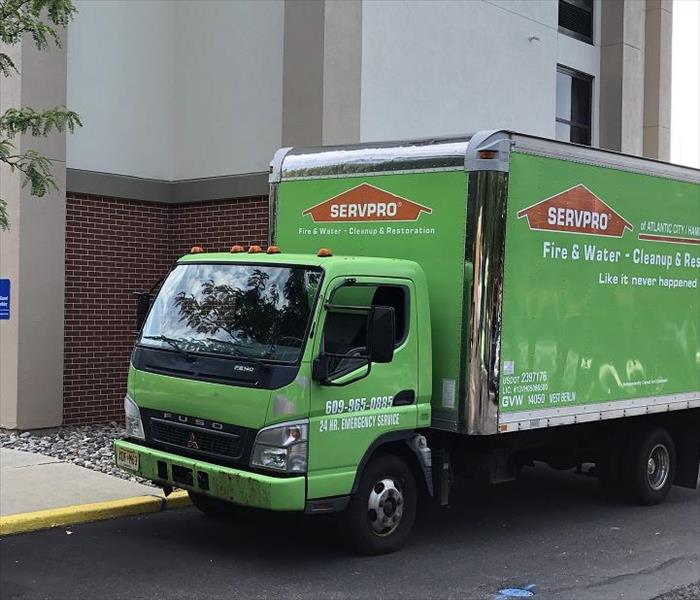 Whether your water damage is large or small, you can trust the SERVPRO brand to quickly dry your home.
Whether your water damage is large or small, you can trust the SERVPRO brand to quickly dry your home.
Understanding the Importance of Flood Removal to Residents of Atlantic City
Thousands of property owners require flood removal services from time to time. Flooding needs addressing as soon as it takes place; otherwise, one must contend with expensive repairs and replacements. It is advisable to let the experts perform the required restoration. Though, there are a few things that residents of Atlantic City can implement to mitigate the damage as they wait for professional help to arrive.
Assessing the safety of the structure should be the first step when conducting flood removal in your Atlantic City home. Some cases may make the structure unsafe to enter since the water may weaken the building. Make sure you shut off electrical supply to the building since submerged electronics and appliances may make one suffer an electrical shock. If the water has been in for over 24 hours, our SERVPRO team encourages you to wear a face mask to avoid breathing in mold spores. Fall and slip accidents are also common in such situations since the floor might be slippery and other items might shift when it floods.
Contaminants such as sewage are common in place flood water, which is why our SERVPRO technicians wear rubber boors when working at the site. If you need to do some of the restoration work by yourself, we advise you to have the necessary disinfectants, cleaning supplies, and tools. Not all cleaners suit all surfaces, so you need to know what is appropriate for your site. With the help of pumps, pails, and vacuums, you can remove standing water. All contaminated and soaked materials need removing from the structure.
After removing the water and thoroughly cleaning the affected surfaces, drying should be the next step. This process should be done as soon as possible to avoid moisture-related challenges such as mold growth and rotting. Where possible, you can open the windows and doors to enhance air circulation. Take wet furnishings and water-damaged furniture out of the house. You may also call our SERVPRO technicians to set in place dehumidifiers to eliminate excess moisture from indoor air and use fans to speed up the drying process.
SERVPRO of Atlantic City / Hamilton / Hammonton has highly trained personnel to attend to all types of emergencies and disasters. Call us at (609) 965-0885 to make your home or business "Like it never even happened."
More about Atlantic City.
Atlantic City Flood Damage Remediation Doesn’t Have to Be Dealt With Alone
7/8/2019 (Permalink)
 Storm and flood damage in Atlantic City can really make the clean up extremely difficult. Contact SERVPRO for remediation assistance.
Storm and flood damage in Atlantic City can really make the clean up extremely difficult. Contact SERVPRO for remediation assistance.
Preparing for Flood Damage to Impact Atlantic City
Considering that many residents of Atlantic City have already seen the disastrous effects of hurricanes and other severe weather conditions, it is crucial to have an emergency plan in place. As simple as you might think that these organizational efforts seem, preparation now can save you from panic and confusion when contending with widespread natural disasters like flood damage.
While emergency plans are a critical part of living in flood damage prone Atlantic City and other coastal communities, many residents do not fully understand what they are to include or how to begin the process. At SERVPRO, we have seen the damage that storms can do and how much worse the situation can become for those unprepared for what is coming, so we encourage everyone to develop their own plan for any flooding situation and hurricane strength storm system passing through the area.
Developing an emergency plan means following a designed system that keeps you and your family safe as you vacate the premises until the storm and elevated risks have passed. There are specific items every plan should have, including:
- A secure location where your family sets to meet should disaster strike when members of the family are not at home.
- A chosen individual responsible for collecting valuables and irreplaceable keepsakes from the home before you vacate.
- Another occupant that can ensure that services like water have gotten shutoff to prevent even costlier damages occurring while you are out of the house.
- Putting together a care bag that has at least one clean outfit for each family member, food, provisions, toiletries, and other necessities in case of temporary displacement in disaster relief shelter in the city.
Knowing what to do in an emergency is much easier when your entire family has rehearsed their role in averting the crisis. Our SERVPRO of Atlantic City / Hamilton / Hammonton professionals can be there when it is time to pick up the pieces, but until then, take care of your household with a plan. When you want to make storm and flood damage “Like it never even happened,” give our team a call at (609) 965-0885.
Click here to see more about Atlantic City.
We Are Available 24/7 For Your Atlantic City Flood Damage Restoration
6/19/2019 (Permalink)
 We have the equipment, expertise and experience to restore your home. We are available 24/7 so call us right away to prevent further damage.
We have the equipment, expertise and experience to restore your home. We are available 24/7 so call us right away to prevent further damage.
Hurricanes and Flooding that Damage Atlantic City Homes
With a history that involves the recovery from Super Storm Sandy and Hurricane Irene for Atlantic City properties, these powerful and destructive storms remain a present threat to homes today as well. As a coastal community, severe weather can constantly shift course in the Atlantic Ocean to breach the shores here. Having a team of dedicated storm responders can help with both relief efforts and ultimately keeping your costs much lower regarding the restoration work to come.
As part of a Large Loss Recovery Team, we can address structural concerns and flood damage to Atlantic City homes quickly and confidently. We know the investment that you have made in your property, and we strive to provide every customer with a fast response and efficient mitigation process to protect their homes from worsening conditions. Preventing the spread of the flood damages must be a primary focus for the SERVPRO professionals dispatched to your address.
From the time that our team first arrives, we work efficiently to establish both containment barriers as well as what must happen to prevent further water penetration from occurring. We have a team of general contractors that arrives with the technicians who can assess the structural damage and provide temporary construction solutions. Once the storm has passed, we can offer a full-scale reconstruction of damaged portions of the house’s exterior.
We know how important it is to leave construction materials installed when possible, so we utilize moisture readers and infrared technology to see beyond walls, flooring, and ceilings to identify the presence of moisture and saturation. With this information, we can more effectively place drying tools to improve their efficiency and reduce overall loss and time restoring the property.
While severe weather is an expectation for many of the area home and business owners, it does not make it any easier to deal with the destruction these systems can cause. Count on our SERVPRO of Atlantic City / Hamilton / Hammonton disaster relief team to provide immediate storm recovery solutions and flood mitigation. Give us a call at (609) 965-0885.
See more about Atlantic City.
Don't Gamble with DIY Flood Damage Cleanup in Atlantic City, Call SERVPRO
6/3/2019 (Permalink)
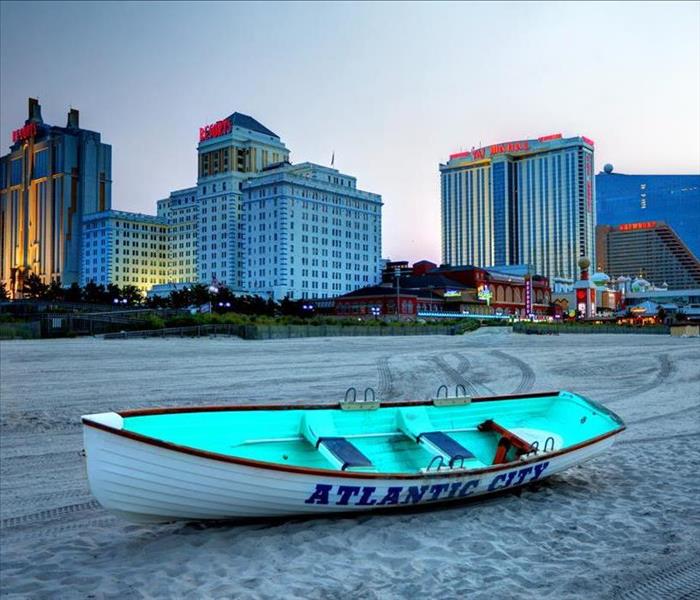 Flood Damage in Atlantic City? SERVPRO Can "Float Your Boat!"
Flood Damage in Atlantic City? SERVPRO Can "Float Your Boat!"
Cleanup and Rebuilding from Flood Damage in Atlantic City
This area of New Jersey is no stranger to water damage from severe weather. Both flash floods and water intrusions caused by storms and hurricanes are potential problems for a property owner.
When an Atlantic City homeowner required assistance with flood damage in her home, our emergency response team advised the caller and her family to avoid the area of the house with exposure to water, and we arrived in a short time later. Because flood water has the potential to contain anything from toxins to sewage, it is rated as a category three or black water when it intrudes on a property. SERVPRO technicians wear protective gear, and we commonly spray any standing water with disinfectants to ensure it is less harmful to engage with during the removal process.
Water migrates following both gravity and the path of least resistance, even after substantial amounts of water enter a home, often there appears to be less water than there actually is. That is why our SERVPRO technicians scope the site and look for areas of high moisture. Common spots are behind baseboards, wicked into sheetrock and in subflooring. We quickly extracted as much of it as possible using portable pumps, squeegees, and other equipment.
When our technicians determined water wicked into the sheetrock that showed signs of buckling, we used thermal imaging to ascertain how far up into the building materials, the elevated moisture levels showed. We then measured six inches above that and cut away the sheetrock, using a technique referred to as "flood cuts." It lets airflow happen in the wall cavity during the drying phase of flood mitigation, lessening any further damage.
Unfortunately, porous home contents such as carpet and padding are nearly always a loss when exposed to black water and require removal from the property for sanitary purposes. Items that do not retain moisture are good candidates for disinfection and restoration.
After drying, we thoroughly disinfect all surfaces and get the area ready for rebuilding. Our crew chief or project manager gives both the homeowner and adjuster a list of the remediation efforts done on the home as well as a list of the necessary repairs and restorations needed to return the home to its preloss condition. We hold a general contractor's license and can handle damage from flooding from cleanup to rebuilding. We can save our customers time and money with this comprehensive service.
Flood damage feels overwhelming and must be handled quickly to prevent as much loss as possible. Call SERVPRO of Atlantic City / Hamilton / Hammonton at (609) 965-0885, and we are available 24/7 to try to make you feel "Like it never even happened."
Come and visit Atlantic City, click here.
September is National Preparedness Month
8/30/2018 (Permalink)
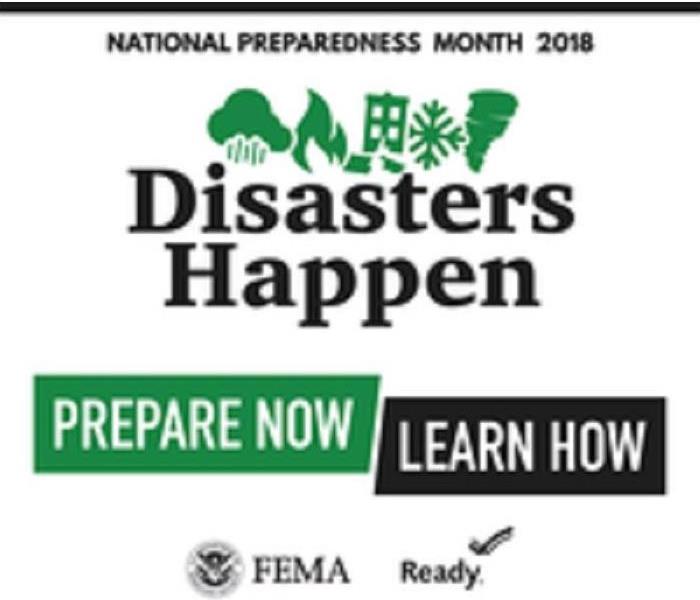 National Preparedness Month
National Preparedness Month
National Preparedness Month recognized each September, provides an opportunity to remind us that we all must prepare ourselves and our families now and throughout the year. This National Preparedness Month will focus on planning, with an overarching theme: Disasters Happen. Prepare Now. Learn How.
For more information visit https://www.ready.gov/
In the Atlantic City region we often focus our attention on Hurricane Season. This is important, but other disasters can impact our lives. Other natural disasters can strike in our area, like severe thunderstorms or blizzards.
It is also important to be aware of man made disasters that can impact us. Fire and Water damage is always a real threat to every home and business.
Let SERVPRO Assist You Now
For help restoring your residential or commercial property after a water or fire loss, call SERVPRO of Atlantic City/Hamilton/Hammonton 24/7/365 at 609-965-0885.
Severe Storm Preparedness for the Atlantic City Area
7/31/2018 (Permalink)
 Be Prepared the Next TIme a Storm Rolls Through
Be Prepared the Next TIme a Storm Rolls Through
Follow These Red-Cross Approved Guidelines to Stay Safe During Severe Thunderstorms
Be Prepared:
- Learn about your local community’s emergency warning system for severe thunderstorms
- Discuss thunderstorm safety and lightning safety with all members of your household
- Pick a safe place in your home for household members to gather during a thunderstorm This should be away from windows, skylights and glass doors that could be broken by strong winds or hail
- Make a list of items to bring inside in the event of a severe thunderstorm
- Make trees and shrubbery more wind resistant by keeping them trimmed and removing damaged branches
- Protect your animals by ensuring that any outside buildings that house them are protected in the same way as your home
- Consult your local fire department if you are considering installing lightning rods
- Get trained in first aid and learn how to respond to emergencies
- Put together an emergency preparedness kit
- Review the Be Red Cross Ready - Thunderstorm Safety Checklist
During a Thunderstorm
- Listen to local news or NOAA Weather Radio for emergency updates. Watch for signs of a storm, like darkening skies, lightning flashes or increasing wind.
- Postpone outdoor activities if thunderstorms are likely to occur. Many people struck by lightning are not in the area where rain is occurring.
- If a severe thunderstorm warning is issued, take shelter in a substantial building or in a vehicle with the windows closed. Get out of mobile homes that can blow over in high winds.
- If you can hear thunder, you are close enough to be in danger from lightning. If thunder roars, go indoors! The National Weather Service recommends staying inside for at least 30 minutes after the last thunderclap.
- Avoid electrical equipment and telephones. Use battery-powered TVs and radios instead.
- Shutter windows and close outside doors securely. Keep away from windows.
- Do not take a bath, shower or use plumbing.
- If you are driving, try to safely exit the roadway and park. Stay in the vehicle and turn on the emergency flashers until the heavy rain ends. Avoid touching metal or other surfaces that conduct electricity in and outside the vehicle.
- If you are outside and cannot reach a safe building, avoid high ground; water; tall, isolated trees; and metal objects such as fences or bleachers. Picnic shelters, dugouts, and sheds are NOT safe.
After a Thunderstorm
Take the Appropriate Steps to Stay Safe
- Never drive through a flooded roadway. You cannot predict how deep the water may be.
- Stay away from storm-damaged areas to keep from putting yourself at risk from the effects of severe thunderstorms.
- Continue to listen to a NOAA Weather Radio or to local radio and television stations for updated information or instructions, as access to roads or some parts of the community may be blocked.
- Help people who may require special assistance, such as infants, children and the elderly or disabled.
- Stay away from downed power lines and report them immediately.
- Watch your animals closely. Keep them under your direct control.
If Lightning Strikes
Follow these steps if someone has been struck by lightning:
- Call for help. Call 9-1-1 or the local emergency number. Anyone who has sustained a lightning strike requires professional medical care.
- Check the person for burns and other injuries. If the person has stopped breathing, call 9-1-1 and begin CPR. If the person is breathing normally, look for other possible injuries and care for them as necessary. People who have been struck by lightning do not retain an electrical charge and can be handled safely.
Let Your Family Know You're Safe
If your community has experienced a disaster, register on the American Red Cross Safe and Well website to let your family and friends know you are safe. You may also call 1-866-GET-INFO to register yourself and your family. Resources to Handle Floods and Storms
When storms hit Atlantic City we can scale our resources to handle a large storm or flooding disaster. We can access equipment and personnel from a network of 1,650 Franchises across the country and elite Disaster Recovery Teams that are strategically located throughout the United States.
Have Storm or Flood Damage? Call Us Today (609) 965-0885
Severe Weather - Thunderstorms
6/25/2018 (Permalink)
 Thunderstorm Season
Thunderstorm Season
What is a thunderstorm?
A thunderstorm is a rain shower during which you hear thunder. Since thunder comes from lightning, all thunderstorms have lightning.
Why do I sometimes hear meteorologists use the word “convection” when talking about thunderstorms?
Usually created by surface heating, convection is upward atmospheric motion that transports whatever is in the air along with it—especially any moisture available in the air. A thunderstorm is the result of convection.
What is a severe thunderstorm?
A thunderstorm is classified as “severe” when it contains one or more of the following: hail one inch or greater, winds gusting in excess of 50 knots (57.5 mph), or a tornado.How many thunderstorms are there?Worldwide, there are an estimated 16 million thunderstorms each year, and at any given moment, there are roughly 2,000 thunderstorms in progress. There are about 100,000 thunderstorms each year in the U.S. alone. About 10% of these reach severe levels.
When are thunderstorms most likely?
Thunderstorms are most likely in the spring and summer months and during the afternoon and evening hours, but they can occur year-round and at all hours. Along the Gulf Coast and across the southeastern and western states, most thunderstorms occur during the afternoon. Thunderstorms frequently occur in the late afternoon and at night in the Plains states.
What kinds of damage can thunderstorms cause?
Many hazardous weather events are associated with thunderstorms. Under the right conditions, rainfall from thunderstorms causes flash flooding, killing more people each year than hurricanes, tornadoes or lightning. Lightning is responsible for many fires around the world each year, and causes fatalities. Hail up to the size of softballs damages cars and windows, and kills livestock caught out in the open. Strong (up to more than 120 mph) straight-line winds associated with thunderstorms knock down trees, power lines and mobile homes. Tornadoes (with winds up to about 300 mph) can destroy all but the best-built man-made structures.
Where are severe thunderstorms most common?
The greatest severe weather threat in the U.S. extends from Texas to southern Minnesota. But, no place in the United States is completely safe from the threat of severe weather.
For help restoring your residential or commercial property after a water or fire loss, call SERVPRO of Atlantic City/Hamilton/Hammonton 24/7/365 at 609-965-0885.
Hurricane Season in the Atlantic City Area
6/19/2018 (Permalink)
 Plan Now!
Plan Now!
Though the national hurricane season normally runs from June 1 through November 30, the peak potential for hurricane and tropical storm activity in New Jersey runs from mid-August through the end of October.
The combination of warm ocean water, humid air, and consistent winds contribute to the formation of “tropical cyclones” – low-pressure systems of circulating winds, clouds and thunderstorms – over the Atlantic Ocean, Caribbean Sea and the Gulf of Mexico.
As they gain strength, these cyclones are classified as tropical depressions, tropical storms or hurricanes. The Saffir-Simpson Hurricane Scale rates hurricane strengths, from Category 1 to Category 5. Most of these storms remain over the ocean without affecting the U.S. coastline. When they approach land, tropical storms and hurricanes can be extremely deadly and destructive – even as far north as New Jersey, and even when they do not make landfall here.
The key threats from an approaching tropical storm or hurricane are WIND, STORM SURGE, FLOODING, and the potential for TORNADOES.
Hurricane WINDS can reach 74-95 mph for a Category 1 storm, to above 155 mph for a Category 5 storm.
The STORM SURGE is a dome of ocean water the hurricane pushes ahead of itself. At its peak, a storm surge can be 25 feet high and 50-100 miles wide. The storm surge can devastate coastal communities as it sweeps ashore.
The thunderstorms and torrential rains that accompany a hurricane can create dangerous and deadly floods or flash floods.
Seventy percent of hurricanes making landfall spawn at least one tornado.
Preparing properly for a hurricane begins long before a storm ever hits.
For additional information for Hurricane preparedness NJ Office of Emergency Management
Spring Thunderstorms are on Their Way!
2/7/2018 (Permalink)
 Stormy Weather Ahead!
Stormy Weather Ahead!
Winter is finally coming to an end, so you know what that means: spring thunderstorms are right around the corner, and now is the perfect time to get ready. Stormy weather conditions in the springtime are wildly unpredictable, but can emerge out of nowhere in a moments notice, so it's important to be prepared for when they do. When word breaks that a storm is incoming this season, make sure to take all of the necessary precautions to ensure that your home will be safest after it passes.
Lightning strikes can cause your home massive amounts of damage, even if lightning doesn't hit your home at all! Power surges to your home could result in personal injury if you are using an electrical device or appliance at the time of a lightning strike. Not to mention the chance that a power surge could send a home device up in flames, resulting in a dangerous and costly house fire! To prevent these type of scenarios, installing a panel or meter serge protector, purchasing and using outlet protectors, or even just unplugging devices and small appliances during a storm could save you an unwanted home devastation this spring.
Aside from lightning strikes, the high winds and heavy rains could also cause you problems with water and structural damages. Prevention, depending on the caliber of the storm, is sometimes impossible; however, some basic tips can give you some added protection for when mother nature makes her way to your town. Making sure all of your doors and windows, are completely sealed when closed is massively important. Even the smallest leaks can wreak havoc. Cleaning your gutters regularly and maintaining your roof regularly will also reduce your risk of large loss during a storm. All water damages are preventable and making sure your roof and gutter are both clean and structurally well is half the battle.
While it is nearly impossible to predict when tragedy will occur, it is SERVPRO of Atlantic City/Hamilton/Hammonton 's job to provide 24-hour emergency service when it does. We are dedicated to being faster to any-sized disaster and can respond immediately to your storm-related issues in your home or business. Our team has the expertise to handle your storm damage needs.
- 24 -Hour Emergency Service
- Highly Trained Technicians
- Specialized Remediation Equipment
SERVPRO of Atlantic City/Hamilton/Hammonton understands the stress and worry that comes with emergency damage and the disruption it causes your life. Our goal is to help minimize the interruption to your life and quickly make it "Like it never even happened."
Have Questions? Call Us Today 609-965-0885
Hurricane Season
6/22/2017 (Permalink)
Hurricane Season is here!
With Tropical Storm Cindy making landfall this week, we at SERVPRO of Atlantic City/Hamilton/Hammonton want to remind everyone about the dangers of hurricanes in our area as well as give you some tips on how to limit the damage. This hurricane season is forecasted as being “busier than usual”, so make sure you, your home, and your loved ones are prepared.
The first step in hurricane preparedness is to know the evacuation routes in your area. Knowing evacuation routes ensure that you and your family are able to evacuate quickly and safely in the event of a mandatory evacuation.
If you are unable to evacuate, make sure that you have plenty of water, batteries, flashlights, a first aid kit, and non-perishable food items handy. If power is lost during the storm, there’s no telling how long it could be out for. Be sure to wait out the storm in a secure room, away from windows.
After the storm has passed, report any downed power lines but DO NOT approach them.
Be prepared and stay safe out there everybody!
Understanding “Derechos”
6/22/2017 (Permalink)
As many of us remember from June of 2012, Derechos can cause significant damage and appear almost out of nowhere. Derechos are most common in late spring and summer, so we at SERVPRO of Atlantic City/Hamilton/Hammonton wanted to remind everyone about the dangers of derechos as well as some give you some tips on keeping safe in the event of a Derecho.
A derecho is a large cluster of thunderstorms that can produce winds of 50-100+ MPH. They have been compared the impact of a derecho to the strength of a land-falling hurricane, while affecting a larger area than a tornado.
To protect your home and your loved ones, be sure to check the weather forecast first. Any severe thunderstorm warnings should be taken seriously, as they could develop into a derecho. Avoid driving or boating during a severe thunderstorm warning. Almost half of derecho-related fatalities have occurred in either cars or boats.
For any storm related damage, call SERVPRO® of Atlantic City/Hamilton/Hammonton at: 609-965-0885.
Do’s and Don’ts to Help Minimize Storm Damage
6/14/2017 (Permalink)
 Summer storms can produce significant lightening.
Summer storms can produce significant lightening.
Do’s and Don’ts to Help Minimize Storm Damage
Do:
- Ensure local authorities have given the “all clear” for your area.
- Ensure your electricity is turned off before entering a flooded structure.
- Remove as much excess water as possible with wet-dry vacuums, mops, and towels.
- Remove and prop wet upholstery and pillow cushions for drying.
- Call SERVPRO Atlantic City/Hamilton/Hammonton at (609)965-0885.
Don’t:
- Use your household vacuum to remove water.
- Leave wet fabrics in place; dry as soon as possible.
- Leave books, magazines or other colored items on wet carpet or floors.
- Use television or other household appliances while standing on wet floors or carpets.
We at SERVPRO® Atlantic City/Hamilton/Hammonton are here to ensure that your home and personal belongings are restored to their original condition after storm damage strikes. Call us at (609)965-0885 for a free estimate, and then take advantage of our professional restoration services performed by our exceptional staff. Let us restore your home “Like it never even happened!”
Water Clean up from Flooding
2/22/2017 (Permalink)
 Localized flooding event
Localized flooding event
Following a water intrusion caused by storm damage calling SERVPRO of Atlantic City/Hamilton/Hammonton is the first and one of the most important calls you can make. In the event that you don't complete the water removal process immediately, your property can be subjected to a plethora of unwanted, unnecessary complications such as mold growth, loss of possessions, and structural damage. If you find yourself in need of water damage services, it's important to find a skilled team of restoration experts like SERVPRO of Atlantic City/Hamilton/Hammonton. We can expedite the water extraction, cleaning, repair, and restoration components of the process. Learn more about the importance of water damage cleanup by reviewing this short reference guide:
Water Cleanup Prevents Mold and Mildew Growth
One of the reasons for securing the services of an experienced water damage cleanup company is inhibiting the growth of mold and mildew in your home. Unfortunately, these fungi can begin thriving and expanding on your property 48-72 hours after the initial water intrusion. Moreover, the moist, warm conditions created by water damage make your residential property a prime location in which mold can develop and proliferate.
Prevent or Diminish Secondary Water Damage to the Structure of Your Home
An additional benefit of rapid water removal is that it prevents structural damage from adversely impacting your property. When left unaddressed for an extended time, the water can wick into walls, and studs, rust appliances, and damage the electrical system. If a natural flooding disaster occurred, then the foundation could also have been compromised.
Why You Should Secure Professional Assistance
Although some people attempt to complete the water cleanup process on their own, this approach is not advisable if it means more than using a mop and a bucket. For volumes of unwanted standing water, our water removal process is expedited and optimized through the use of specialized equipment. Our high volume vacuum extractors remove water quickly. This means less the water damage to furniture, walls, flooring, electronics, and personal possessions. This helps to remove water and treat damage that you can’t see. After extraction is complete we apply a plant based anti-microbial and then begin the drying process. Our specialty drying equipment will be placed strategically to promote rapid drying. It is important to get remaining structural materials dry to prevent the mold and microbial growth.
Let SERVPRO Assist You Now
For help restoring your residential commercial property after a water or fire loss, call SERVPRO of Atlantic City/Hamilton/Hammonton 24/7/365 at 609-965-0885. We’ll make it “Like it never even happened.”
What To Do Before, During And After A Thunderstorm
5/27/2016 (Permalink)
Warmer weather brings increased chances of thunderstorms.
Before
· Remember the 30/30 Lightning Safety Rule: Look for lightning and go indoors if you cannot count to 30 before hearing thunder; stay indoors for 30 minutes after hearing the last thunder-clap
· Consider investing in a personal lightning detector
· Remove dead or rotting trees and branches that could fall
· Secure outdoor objects that could blow away or cause damage
· Shut all windows and secure outside doors
· Unplug electronic equipment
During
· Avoid contact with electrical equipment or cords, including devices plugged in for recharging (consider unplugging valuable electronics in case of power surge)
· Water conducts electricity, so avoid contact with plumbing
· Stay away from windows and doors and stay off porches
· Do not lie on concrete floors or lean against concrete walls
· Avoid natural lightning rods, such as tall isolated trees, and avoid isolated small structures in open areas
· Avoid contact with metal, including farm equipment, motorcycles, golf carts and bicycles
· If you are driving, safely exit or pull over and park; do not touch any surface that conducts electricity in or outside of the vehicle
After
· Never drive through a flooded roadway
· Avoid storm-damaged areas
· Help people who may require special assistance
· Stay away from downed power lines and report them immediately
· Watch your pets closely; keep them indoors if possible
Dealing With Flooding Due to Storm Damage?
1/27/2016 (Permalink)
Dealing With Flooding Due to Storm Damage?
If you are dealing with storm damage and flood cleanup you’ll appreciate tips from The Institute of Inspection, Cleaning and Restoration Certification (IICRC). The IICRC with industry-wide participation, certifies and develops certifications and standards for inspection, cleaning and restoration.
Flood victims can follow a few simple steps to reduce property damage and limit health risks.
Flooding occurs when rising water overflows the natural boundaries of bodies of water, such as rivers and streams, and flows across the ground picking up all kinds of contamination. The water can be contaminated with soil bacteria, decaying insects, animal droppings, oils and fluids from roadways, and fertilizers and pesticides from fields or gardens.
The IICRC offers these tips to clean up after floods:
- Use caution when entering buildings.Make sure electrical power is off and the structure is sound before entering and inspecting a flooded building. Small animals or reptiles may also seek shelter inside a structure, so be cautious when repositioning contents or removing materials.
- Protect yourself. Wear an organic vapor respirator, available from paint or building supply stores, along with rubber gloves, eye protection and protective clothing. Ventilate affected areas by opening windows, and eventually, by placing a fan in a window. Work toward the fan as you clean to minimize cross contamination.
- Know what items to throw away. Porous items that absorb contaminated flood water shouldn't be restored. Drywall, carpet and pad, mattresses, pillows, box springs and particle board normally should be discarded if wet.
- Wet clothing and many household fabrics may be salvageable. Machine washing, including at least a 10-minute soak in detergent and hot water, should remove most contamination and stains.
- Open pockets of saturation.Remove base molding and portions of damaged walls and wet insulation. Locate the water line and measure 15 inches to 20 inches above it. Everything below that should be removed and discarded. Flooring, such as hardwood, laminate or sheet vinyl, should be removed to expose pockets of saturation underneath for cleaning, sanitizing and drying.
- Clean aggressively. Wall cavities and exposed durable materials (studs, joists) should be cleaned by pressure washing with detergent solutions. After thoroughly cleaning and flushing salvageable materials, apply a disinfectant solution liberally. A water restoration professional may be needed to perform this service safely and effectively.
- Prevent mold growth. Although it takes a few days to appear, mold thrives in a moist environment with organic material (e.g., paper or particle board), and temperatures between 68°F and 86°F. Keep air moving and maintain moderate temperatures as possible.
- Dry out before you rebuild. To prevent dry rot and on-going structural damage, don't reconstruct or cover wood materials until its moisture content falls below 16 percent. Moisture meters are available online, but it may be best to hire a water restoration professional to confirm proper drying before reconstruction.
Consider hiring a professional. A professional water damage restoration company like SERVPRO of Atlantic City/Hamilton/Hammonton has trained technicians, specialized cleaners and antimicrobial agents, and extraction, drying, dehumidifying and moisture measuring equipment.
At SERVPRO of Atlantic City/Hamilton/Hammonton, our technicians are IICRC trained and certified and will be glad to assist with your storm flood cleanup effort. Call 609-965-0885 to speak to a Franchise Professional today!
Winter Storm Jonas - Property Protection Tips
1/22/2016 (Permalink)
Heavy snow accumulation can pose a threat to your home or business; not only as it builds up, but also as it melts. Here are things to watch for:
•Watch for snow accumulation on the leeward (downwind) side of a higher-level roof, where blowing snow will collect. For safe removal that won't endanger you or damage your roof, consult a roofing contractor for a referral.
•Remove snow from basement stairwells, window wells and all walls. Melting snow can lead to water damage and moisture intrusion.
Ice dams are an accumulation of ice at the lower edge of a sloped roof. When interior heat melts the snow, water can run down and refreeze at the roof's edge, where it's much cooler. Should ice build up and block water from draining off the roof, the water is then forced under the roof covering and into your attic or down the inside walls of your property.
•Make sure your gutters are clear of leaves and debris.
•Keep the attic well ventilated so snow doesn't melt and refreeze on the roof's edge.
•Make sure the attic floor is well insulated to minimize the amount of heat rising through the attic from within the house.
Water intrusion and flood damage from melting snow and ice can threaten property, but by taking the following steps it can help minimize the potential for damage.
Immediately after the threat of physical danger has passed:
•Make sure the building is structurally safe to enter or reoccupy.
•Turn off electrical power. Do not use electricity until it is safe to do so.
•Ensure that natural gas sources are safely secured.
•Secure the exterior to prevent further water intrusion. This can include boarding up broken windows, making temporary roof repairs, sealing cracks or tacking down plastic sheeting against open gaps in walls or roofs.
When it's safe to begin cleanup:
•Disconnect all electronics/electrical equipment and move it to a safe, dry location.
•Begin to remove water-damaged materials immediately.
•Contact SERVPRO of Haddon Heights/Voorhees or Hamilton/Hammonton for assistance with extraction and drying.
•By taking immediate action, you will reduce the amount of damage and increase the chance of salvaging usable materials. You'll also reduce the amount of rust, rot, mold and mildew that may develop, and lower the likelihood that the water will lead to structural problems.




 24/7 Emergency Service
24/7 Emergency Service
